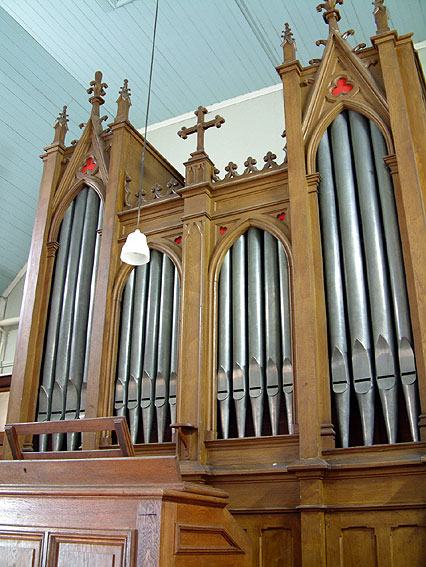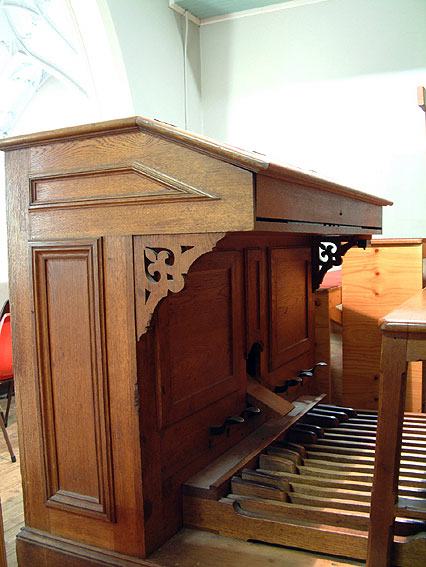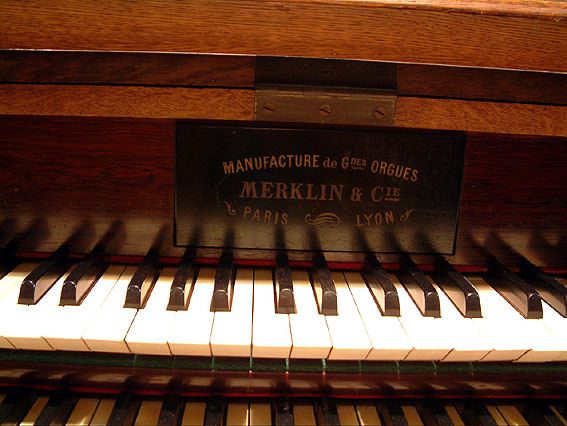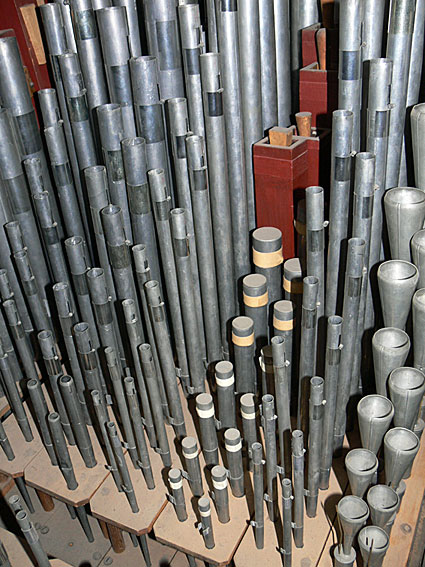Convent Chapel of Sacre Coeur
Glen IrisMerklin & Cie, Paris & Lyon 1889
built for St Joseph's Convent, Marseilles, France and
installed at Glen Iris by George Fincham & Son, 1905
Photo: Trevor Bunning (Oct. 2008)
The Melbourne house established in 1884 by Sacré-Coeur nuns was in many ways a ‘picture-postcard’ replica of the enclosed environments of the Sacré-Coeur maisons as they were in France. The turret clock on the south face was transported from the house in Bordeaux, the oak stalls in the chapel came from Angoulême, the marble altar in the chapel came from Lille, the Merklin organ had been transported there from the Marseilles house by sea. The main buildings were designed by Reed Smart & Tappin in the Gothic style with tall red brick walls, slate roofs and apsidal chapel projecting to the west, this being internally vaulted in plaster. Adjacent to the convent buildings is the mansion ‘Brynmawr’, a two-storey building of 1859 designed in the classical style by architect George Wharton.
The organ was built by the important French firm of Merklin & Cie, Paris & Lyons, in 1889 [1] for St Joseph's Convent, Marseilles. When the Religious Order was disbanded by government decree, the organ was shipped to Melbourne and erected in the Chapel of Sacré Coeur by George Fincham & Son in 1905. [3] Apart from the addition of electric blowing, the organ appears to remain totally intact and is thus a rare example of French romantic organbuilding in Australia, the only two other examples being the 1870 Merklin-Schütze, Brussels organ originally in St John’s Church, Toorak, later in Cato Uniting Church, Elsternwick and now in storage at the Australian Catholic University’s Central Hall, Fitzroy, and the 1890 Théodore Puget et Fils, Toulouse organ at Sacred Heart Chapel, Kincoppal, Rose Bay, Sydney.
The oak Glen Iris console is reversed, with terraced rosewood stop-jambs and foot-operated couplers; the Gothic case has been grained in an oak finish. A sympathetic restoration was undertaken in 1984 by George Fincham & Sons Pty Ltd which included complete restoration of the pipework, including the front pipes, which were collapsing; cleaning; repair of non-return valves and conveyances; rebushing pedal coupling action and roller arms; and regulation of action and pipework. Also, the swell shutters were made to open more fully than previously.[4] The result of this work has been highly successful: the sound of the organ has been immeasurably improved and the action made far more responsive.[5] An outstanding CD recording ( CD ISCD 017 ) of the Merklin organ was made in 1996 by former pupil Ingrid Sykes.
Click here to download a track, used with Ingrid's permission, of Vierne's Préamble
The specification is:
GRAND ORGUE
Bourdon
Flûte Harmonique
Dulciana
Flûte Octaviante
Récit à Grand Orgue *
RECIT
Bourdon
Gambe
Voix Céleste
Basson et Hautbois
PÉDALE
Soubasse
Bourdon
Grand Orgue à Pédale *
16
8
8
4
8
8
8
8
16
8
G.O.
G.O.
Basson et hautbois +/- *
Tremblant *
Balanced general swell pedal
mechanical action
organ totally enclosed in general swell
compass: 54/25
* operated by foot pedals
[1] Date derived from pipework markings (Gambe = 26 Août 1889; Bourdon C.G. 10 Août 1889) kindly supplied by Michel Alcouffe.
[2] Pers.comm. David Fincham to John Maidment June 1984.
[3] E.N. Matthews Colonial organs and organbuilders Carlton: Melbourne University Press, 1969., p.135.
[4] Specification of work to be done: 14 June 1984.
[5] Visit to organ: John Maidment 22 August 1984.
Photos © PdL
Donn Mendoza demonstrating the organ
Photo: Trevor Bunning (Oct. 2008)

Basson et Hautbois

Three photos above: JRM (Dec 2011)








